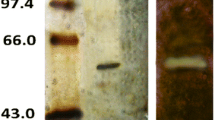Abstract
Extracellular lipase was produced from Rhizopus oligosporus NRRL 5905 through solid state fermentation (SSF). To provide an optimum fermentation conditions for maximum lipase yield, five process variables (temperature, liquid–solid ratio, pH, incubation period and spore concentration) were optimized using evolutionary operation (EVOP) factorial design technique taking into account the interaction between the process variables. Optimization through EVOP resulted in around 3 fold increase in lipase activity (77 U gds−1) at a liquid–solid ratio of 1.5:1, fermentation temperature of 35°C, initial fermentation pH 6, incubation period 5 days and a spore concentration of 108 spores ml−1.
Similar content being viewed by others
References
Jaeger KE, Reetz TM (1998) Microbial lipases form versatile tools for biotechnology. Trends Biotechnol 16:396–403
Kazlauskas RJ, Bornscheuer UT (1998) Biotransformations with lipases. In: Rehm HJ, Pihler G, Stadler A, Kelly JW (eds) Biotechnology, vol VIII. VCH, New York, pp 37–192
Jaeger KE, Eggert T (2002) Lipases for biotechnology. Curr Opin Biotechnol 13:390–397
Saxena RK, Ghosh PK, Gupta R, Davidson WS, Bradoo S, Gulati R (1999) Microbial lipases: potential biocatalysts for the future industry. Curr Sci 77:101–115
Hölker U, Höfer M, Lenz J (2004) Biotechnological advantages of laboratory-scale solid-state fermentation with fungi. Appl Microbiol Biotechnol 64:175–186
Krishna C (2005) Solid-state fermentation systems—an overview. Crit Rev Biotechnol 25:1–30
Hölker U, Lenz J (2005) Solid-state fermentation—are there any biotechnological advantages? Curr Opin Microbiol 8:301–306
Kohno M, Kugimiya W, Hashimoto Y, Morita Y (1994) Purification, characterization and crystallization of two types of lipase from Rhizopus niveus. Biosci Biotechnol Biochem 58:1007–1012
Kumar KK, Deshpande BS, Ambedkar SS (1993) Production of extracellular acidic lipase by Rhizopus arrhizus as a function of culture conditions. Hindustan Antibiot Bull 35:33–42
Hiol A, Jonzo MD, Rugani N, Druet D, Sarda L, Comeau LC (2000) Purification and characterization of an extracellular lipase from a thermophilic Rhizopus oryzae strain isolated from palm fruit. Enzym Microb Technol 26:421–430
ul-Haq I, Idrees S, Rajoka MI (2002) Production of lipases by Rhizopus oligosporus by solid-state fermentation. Process Biochem 37:637–641
Nahas E (1988) Control of lipase production by Rhizopus oligosporus under various growth conditions. Microbiology 134:227–233
Box GEP (1957) Evolutionary operation: a method for increasing industrial productivity. Appl Stat 6:3–23
Banerjee R, Bhattacharya BC (1992) Evolutionary operation (EVOP) to optimize protease biosynthesis by Rhizopus oryzae. Bioprocess Eng 8:151–155
Banerjee R, Bhattacharyya BC (1993) Evolutionary operation (EVOP) to optimize three-dimensional biological experiments. Biotechnol Bioeng 41:67–71
Tunga R, Banerjee R, Bhattacharyya BC (1999) Optimization of n variable biological experiments by evolutionary operation-factorial design technique. J Biosci Bioeng 87:224–230
Kar B, Banerjee R, Bhattacharyya BC (2002) Optimization of physicochemical parameters for gallic acid production by evolutionary operation—factorial design technique. Process Biochem 37:1395–1401
Kordel M, Hofmann B, Schomburg D, Schmid RD (1991) Extracellular lipase of Pseudomonas sp. strain ATCC-21808, puritication, characterization, crystallization, and preliminary X-ray diffraction data. J Bacteriol 173:4836–4841
Davis OL (1954) Design and analysis of industrial experiments. Hafner Publishing Co, New York, pp 440–480
Adler YuP, Markos EV, Granovsky YuV (1975) The design of experiments to find optimal conditions. Mir Publishers, Moscow, pp 118–144
Box GEP, Hunter JS (1959) Condensed calculation for evolutionary operation programs. Technometric 1:77–95
Pearson ES, Hartley HO (1962) Biometrika tables for statisticians 1. University Press, Cambridge, p 46
Acknowledgements
The authors wish to acknowledge Department of Biotechnology and Council of Scientific and Industrial Research for providing financial support to carry out this work.
Author information
Authors and Affiliations
Corresponding author
Rights and permissions
About this article
Cite this article
Mahapatra, P., Kumari, A., Garlapati, V. et al. Optimization of Process Variables for Lipase Biosynthesis from Rhizopus oligosporus NRRL 5905 Using Evolutionary Operation Factorial Design Technique. Indian J Microbiol 50, 396–403 (2010). https://doi.org/10.1007/s12088-011-0071-z
Received:
Accepted:
Published:
Issue Date:
DOI: https://doi.org/10.1007/s12088-011-0071-z




